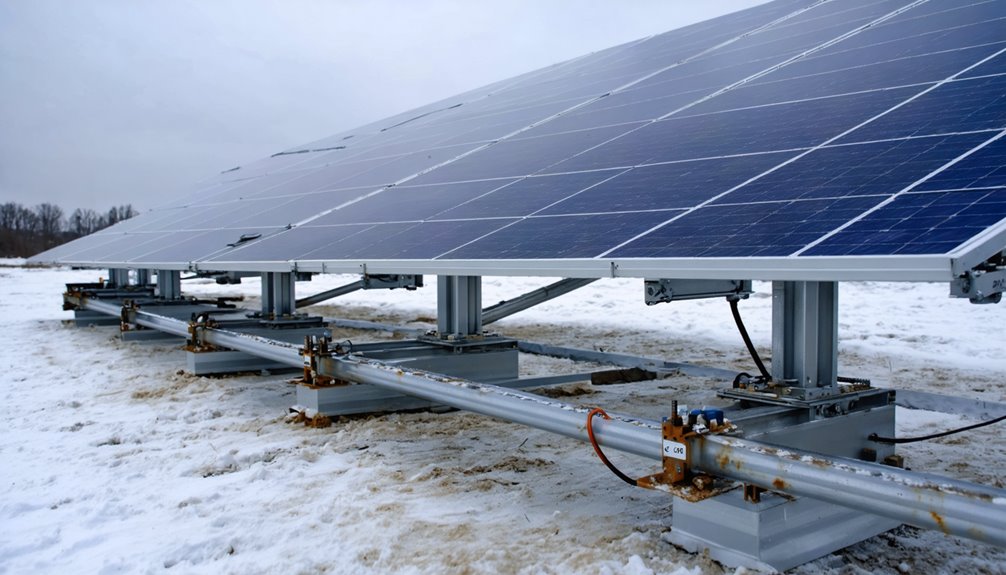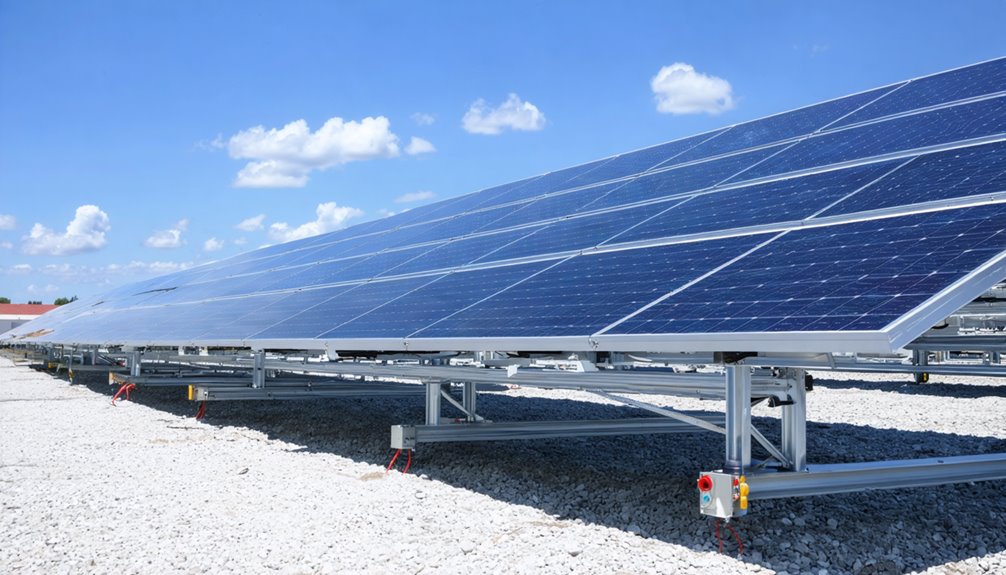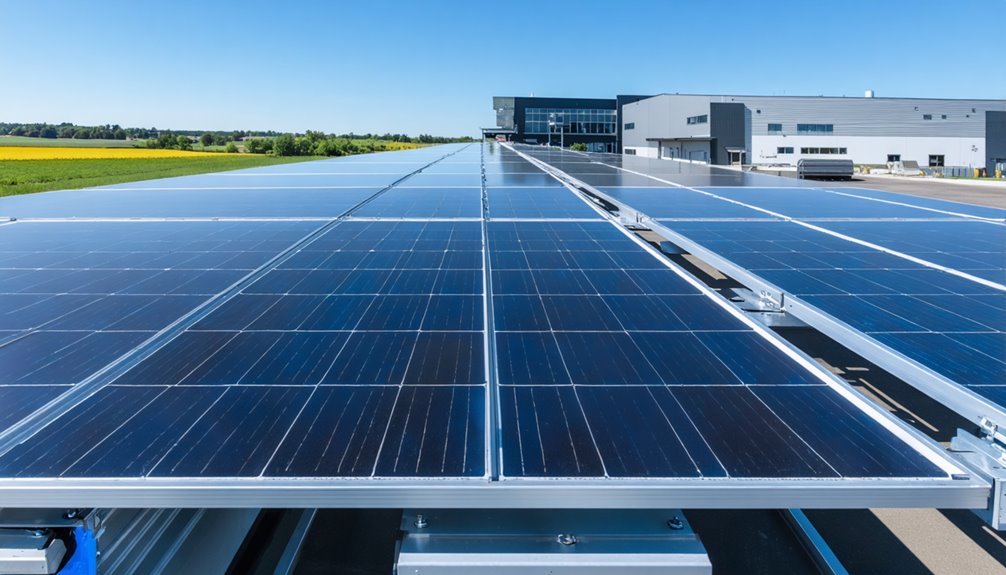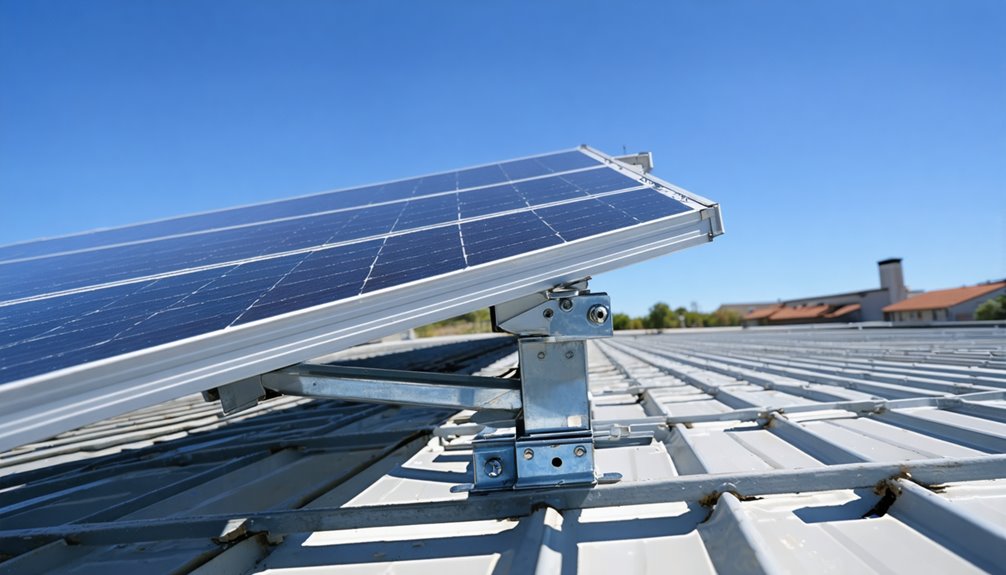When choosing factory solar panel tilt mounts, consider compatibility with panel sizes and weights, ensuring ideal angle adjustments for solar efficiency and durability against weather conditions. Evaluate ease of installation and maintenance, along with features enhancing energy capture. Opt for corrosion-resistant materials like stainless steel or coated aluminum, and review customer feedback for insights on installation efficiency. Trust in brand reliability with compliance certifications. There’s more to discover about maximizing your solar energy capture.
Factors to Consider When Purchasing Factory Solar Panel Tilt Mounts
When purchasing factory solar panel tilt mounts, it’s essential to evaluate the installation slope tolerances, as they can greatly impact the alignment and efficiency of your solar panels. Be sure to factor in wholesale considerations like minimum order quantities and lead times when planning large deployments. Consider mounting solutions that offer flexibility, accommodating different slope variations. For instance, models like the Origin 1P Tracker provide tolerances of ± 15% for North-South slopes and ± 20% for East-West slopes, ensuring proper alignment necessary for ideal solar installation. You should also verify the durability and certifications of your chosen mounts; look for UL 3703 and NEC compliance, which assure resilience against extreme weather conditions such as wind speeds up to 150 mph and heavy snow loads. These features enhance the longevity and performance of your solar energy systems.
Compatibility With Panel Size and Weight
Compatibility with panel size and weight is an important consideration when selecting factory solar panel tilt mounts, as even slight mismatches can lead to inefficiencies in energy capture or structural stress. Standard residential panels typically measure around 40 inches wide by 66 inches long, weighing between 40 to 50 lbs. It’s vital to match these with mounts designed for specific weight limits, often supporting up to 75 lbs. Variability in mount design imposes the need to verify compatibility with your panel’s dimensions, especially since maximum module widths on mounts range from 60 to 70 inches. Additionally, the mount’s track and hinge design must sufficiently accommodate the necessary tilt angle for ideal energy capture, maintaining stability and safety without exceeding the mount’s intended weight thresholds. Additionally, ensure the mount’s wind load rating matches your site’s exposure wind load.
Importance of Optimal Angle Adjustments for Solar Efficiency
When enhancing solar efficiency, you need to take into account that maximizing sunlight exposure hinges on proper angle adjustments, as panels positioned at the ideal tilt—often matching the latitude—can increase energy output by 25-50% compared to improperly tilted systems. Seasonal adjustments using adjustable tilt mounts offer further benefits, allowing panels to better capture sunlight throughout the year and potentially gain an additional 15-20% in solar energy. Incorporating advanced tracking systems, which adapt to daily solar movement, can enhance energy production by 25-40%, underscoring the significant impact of angle and orientation on achieving superior solar efficiency. In practice, a fixed tilt close to the site latitude often yields the best year-round performance for many installations.
Maximizing Sunlight Exposure
Properly adjusting the tilt angles of solar panels is essential for maximizing sunlight exposure and efficiency, particularly as this can increase energy capture by up to 25%, depending on your geographic location and the seasonal changes in the sun’s path. Employing solar mounts with fixed tilt settings, calibrated to the correct angle, facilitates constant best positioning of solar panels, thereby enhancing energy production during peak sunlight hours. Incorporating tilt adjustments to match seasonal variations, such as angling panels between 30 to 45 degrees, greatly contributes to maximal sunlight capture, especially in the lower sun positions of winter. Employing solar trackers offers dynamic angle enhancements, increasing efficiency by 10-40% relative to fixed mounts. Such systems automatically follow the sun’s daily movement, ensuring continuous ideal solar exposure.
Angle Impact on Output
Adjusting the angle of your solar panels is essential for optimizing energy output, as a well-calibrated tilt can greatly enhance solar efficiency compared to fixed installations. Optimizing the tilt angle of your solar panels can considerably boost solar energy capture, often increasing efficiency by 15-20%. The angle markedly impacts how well your panels collect solar energy; ideally, the tilt should match the latitude of your installation site. Although fixed mounts typically use a 30-45 degree angle in mid-latitudes, ground-mounted panels benefit even more from adjustable tilt systems, accommodating various terrains and maximizing sunlight capture. Solar tracking systems, which automatically adjust the angle to follow the sun’s movement, can further amplify energy production, enhancing efficiency over fixed systems by 25-35%.
Seasonal Adjustment Benefits
Maximizing solar panel efficiency isn’t just about determining the right angle at installation; it necessitates ongoing adjustments to adapt to seasonal variations. Seasonal adjustments enhance solar mounting systems, ensuring panels capture maximum sunlight year-round. The ideal tilt angle, which changes with geographical location and time of year, is essential for harnessing solar energy efficiently. For instance, steeper angles in winter minimize snow accumulation, maintaining uninterrupted energy generation. Data suggests that adjusting the tilt angle seasonally can boost solar energy production by up to 25% compared to fixed systems, especially in areas with significant seasonal differences. These adjustments not only enhance efficiency but also prolong the lifespan of solar panels by minimizing electrical strain from fluctuating loads, maintaining peak performance consistently.
Evaluating Durability and Weather Resistance

When evaluating the durability and weather resistance of factory solar panel tilt mounts, it is crucial to take into account several technical specifications and design features that guarantee longevity under varying environmental conditions. Focus on products that meet UL 3703 certification, as these certify durability and reliable performance. For weather-resistant materials, prioritize mounts constructed from stainless steel or coated aluminum, as they resist humidity and corrosion effectively. Innovative solutions, such as Polar Racking’s Severe Weather Protection, address challenges presented by heavy snow loads, hail, and high winds by reinforcing structural integrity and incorporating watertight seals. Consider dual foundation designs like the GLIDE Fuse, which not only support heavier loads but also increase resistance against extreme conditions, ensuring the ideal protection and lifespan of your solar installation. Additionally, ensure UL 3703 certification to verify durability and reliable performance across conditions.
Ease of Installation and Maintenance Considerations
Although the installation process for factory solar panel tilt mounts can initially seem intricate, many systems are designed with user-friendly features that greatly streamline the setup. Pre-assembled components simplify your workflow, reducing labor hours by up to 36% and providing ease of installation. Adjustable mounting rails allow flexibility in adjusting panel angles, optimizing energy production without requiring complex tools. These systems cater to diverse roof types, ensuring compatibility and structural integrity while enhancing weather resistance. Maintenance considerations are paramount, with designs facilitating easy access to panels for routine inspections and cleaning. Utilizing durable materials, like corrosion-resistant metals, these mounts promise longevity, reducing the frequency and financial burden of maintenance, consequently ensuring a dependable solar setup with minimal upkeep over time. Always assess wind loads for the mounting location to ensure safety and performance.
Choosing Durable Mounting Hardware for Outdoor Use
When selecting mounting hardware for outdoor solar panel installations, it’s essential to prioritize materials like stainless steel that offer superior resistance to corrosion and rust, ensuring durability in harsh weather conditions. Opt for advanced fastening techniques, such as self-flashing systems or watertight sealing technologies, to prevent leaks and enhance installation stability. Also, consider components that have undergone thorough longevity and performance testing, as certified hardware for high wind speeds and substantial snow loads will provide greater reliability over time.
Weather-Resistant Material Selection
To guarantee the longevity and performance of solar panel installations in challenging outdoor environments, choosing mounting hardware made from corrosion-resistant materials is essential. Opt for stainless steel or aluminum to withstand harsh weather conditions. These weather-resistant materials resist rust and weather-induced deterioration, ensuring stable installation over time. Additionally, employing weather-resistant coatings such as powder coating or anodizing further protects against UV rays, moisture, and salt spray, extending the lifespan of your hardware. Be mindful of load ratings, especially in areas susceptible to heavy snowfall or strong winds, to avoid structural failures. Consider fasteners with weather seals or gaskets to prevent water ingress and subsequent rust. Regular inspections for wear and damage can enhance the security and efficiency of installations.
Optimal Fastening Techniques
In optimizing fastening techniques for solar panel installations, selecting durable mounting hardware is paramount to ensuring long-term performance and resilience in outdoor environments. High-quality materials like stainless steel or aluminum are essential for resisting corrosion in various weather conditions. Ensuring your solar racking setup adheres to UL 2703 standards guarantees safety and performance compliance.
The following table helps summarize key considerations:
| Material | Feature | Benefit |
|---|---|---|
| Stainless Steel | Corrosion Resistance | Longevity in harsh conditions |
| Aluminum | Lightweight Strength | Ease of installation |
| Weatherproof Seals | Moisture Protection | Structural integrity |
Opt for hardware with suitable tensile strength to combat wind and snow forces, thereby enhancing mount durability. Regular inspections prevent loosening or degradation, preserving functionality and reducing operational cost.
Longevity and Performance Testing
Achieving ideal durability in solar panel installations hinges on your choice of mounting hardware, which plays a vital role in maintaining performance and reducing long-term costs. Selecting materials like stainless steel and aluminum is essential due to their longevity and corrosion resistance, especially in harsh outdoor conditions. Performance testing is fundamental; make certain the mounting system can withstand wind loads up to 150 mph and snow loads of 100 psf. Certification standards such as UL 3703 and IEC 62817 confirm the hardware’s ability to endure environmental stresses. Precision engineering and advanced coatings enhance the resilience of the mounts. Regular maintenance, including inspections and preventive measures against wear, can further extend the lifespan of the solar panel tilt mounts, guaranteeing continued functionality.
Researching Reliable Brands for Factory Solar Panel Tilt Mounts

When considering reliable brands for factory solar panel tilt mounts, it’s crucial to focus on well-established manufacturers known for their durable and effective solutions, such as IronRidge and Unirac. These brands are prominent in the domain of solar systems, offering mounting solutions that adhere to rigorous standards like UL 3703 and NEC compliance, ensuring safety and structural integrity. It’s important to choose tilt mounts with weather-resistant capabilities and innovations targeted at efficient installation while reducing maintenance costs. OMCO Solar’s considerable experience in projects reaching up to 14.8 MW further underscores their reliability in large-scale installations. To gauge installation ease and long-term performance, evaluate customer reviews and testimonials, and consider brands providing extensive support and warranties as clear indicators of quality.
The Role of Mounting Surface in Solar Panel Efficiency
Paying attention to roof orientation is essential for solar panel efficiency, as it directly influences how much sunlight your panels receive throughout the day, thereby affecting energy output; ideally, your panels should face true south in the northern hemisphere or true north in the southern hemisphere. Additionally, the ground slope plays a significant role in determining the type of mounting system you’ll need, especially since uneven or sloped surfaces can complicate installations; mounting systems like the Origin 1P Tracker can accommodate slopes up to ± 15% while maintaining high performance. By ensuring ideal orientation and understanding ground slope considerations, you’ll maximize sunlight capture and maintain the efficiency of your solar panel system.
Roof Orientation Impact
While the orientation of your roof is a critical factor in solar panel efficiency, understanding the role of the mounting surface is equally important as it directly impacts how much sunlight the panels can effectively absorb. Roof orientation greatly influences energy production; south-facing roofs often yield maximum sunlight exposure, enhancing efficiency. However, if your roof orientation is east-west, employing roof mounts with dual-axis tracking systems can adjust the roof tilt angles throughout the day, improving solar exposure. Ideal roof tilt angles between 30 to 45 degrees can increase absorption by up to 20% compared to flat surfaces. Regular maintenance of roof mounts is essential since debris accumulation or shading can lower performance. Additionally, local climate and potential shading from surrounding structures must be considered for peak efficiency.
Ground Slope Considerations
Understanding ground slope considerations is essential when evaluating the efficiency of solar panel installations, particularly as the mounting surface plays a significant role in maximizing energy capture. Ground mounts should be carefully selected based on the terrain’s slope, as it directly impacts fixed-tilt mounting systems and solar trackers. Fixed-tilt systems can accommodate North-South slopes up to ± 15% and East-West slopes up to ± 20%, ensuring stability and efficiency. However, solar trackers, like the Origin 1P and 2L, excel in adjusting panel angles dynamically, maintaining ideal positioning despite slope variations. Specialty systems such as GLIDE Wave support slopes up to 15%, offering stability under challenging conditions like heavy snow and strong winds. Choosing adaptable designs can mitigate uneven surface challenges effectively.
Enhancing Energy Capture With Factory Solar Panel Tilt Mounts
Factory solar panel tilt mounts play a critical role in enhancing energy capture, as they are precisely engineered to optimize the angle of solar panels, thereby maximizing solar radiation absorption throughout the year. By aligning the tilt mounts correctly, you can increase solar energy generation by 20-30%, especially in regions with high solar insolation. These mounts allow solar panels to follow the sun’s trajectory, ensuring ideal exposure. They’re built with durable materials to withstand harsh weather conditions, like high winds and heavy snowfall, maintaining system longevity and reliability. Additionally, tilt mounts facilitate easier cleaning and maintenance, ensuring dust and debris don’t hinder energy production. Many mounts offer compatibility with various panel sizes, providing flexibility in system design while adhering to industry standards.
Reading Customer Reviews for Informed Decisions
In addition to optimizing solar energy capture through precise engineering, making informed decisions about factory solar panel tilt mounts requires thorough analysis of customer reviews. You should meticulously evaluate reviews for insights into the mounts’ durability under varied weather conditions, noting mentions of high winds and snow loads. Look for testimonials about ease of installation, as efficient installation times can greatly cut labor costs. Verify the compatibility of the tilt mount with your specific solar panel brand and model, ensuring a seamless fit. Moreover, evaluating feedback on customer support and warranty services is vital to determine the manufacturer’s reliability and responsiveness in addressing issues. Such extensive evaluation of customer reviews fosters informed decision-making, ensuring robust, reliable solar panel installations.
Maximizing Energy Capture Throughout the Day

When optimizing solar energy systems, adjustable factory tilt mounts are essential for maximizing energy capture throughout the day by allowing panels to align more precisely with the sun’s trajectory. By enabling solar panels to maintain ideal angles, these tilt mounts can greatly boost energy production compared to fixed installations, with potential increases ranging from 20-30% depending on seasonal sun angles and geographical factors. The dynamic adjustment capabilities of tilt mounts facilitate ongoing orientation changes, critical for capturing the maximum amount of sunlight as the solar position shifts. Additionally, tilt mounts help minimize shading from nearby structures or vegetation, ensuring that your panels consistently operate at peak efficiency. Incorporating these mounts can be fundamental for tapping into the full potential of solar energy solutions.
Comparing Different Factory Tilt Mount Options
Adjustable tilt mounts play a pivotal role in optimizing solar energy systems, yet the selection of the right factory tilt mount option is paramount to achieve maximal efficiency and flexibility. Tilt mounts offer adjustable angles that maximize solar energy capture, customizing mounting solar setups to seasonal sunlight variations. Typically accounting for 10-20% of total installation costs, high-quality mounts promise durability and weather resistance. Options like the EcoFasten RockIt system emphasize easy installation with minimal tools, expediting project timelines. Many tilt mounts are customizable for various panel sizes and weights, accommodating diverse solar technologies. Advanced systems by companies such as IronRidge boast UL 2703 certifications, ensuring safety and performance under extreme weather, thereby providing a reliable racking system for your solar needs.
Conclusion
When purchasing factory solar panel tilt mounts, consider compatibility with your panel’s size and weight, as this guarantees secure attachment and ideal functionality. The ability to adjust angles can greatly enhance solar efficiency by maximizing sun exposure. Assess the mounts’ durability and weather resistance to guarantee longevity, especially in harsh climates. Prioritize ease of installation and maintenance to streamline setup and upkeep. Reading customer reviews provides valuable insights, helping you make informed decisions about different factory tilt mount options.
Selecting the right factory solar panel tilt mounts requires careful evaluation of compatibility, adjustability, durability, and installation requirements to ensure optimal system performance and longevity. Solocity Global serves as a trusted exporter of solar panel mounting systems, providing high-quality, standards-compliant mounting solutions to clients worldwide.


